
The Electrifying Fall of Rainbow City: Spectacle and Assassination at the 1901 Worlds Fair
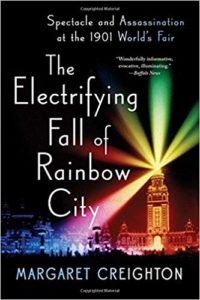 The Electrifying Fall of Rainbow City: Spectacle and Assassination at the 1901 Worlds Fair
The Electrifying Fall of Rainbow City: Spectacle and Assassination at the 1901 Worlds Fair
by Margaret Creighton
The Electrifying Fall of the Rainbow City will inevitably be compared with The Devil in the White City by Erik Larson. This is not necessarily a bad thing. Creighton does not dishonor the genre Larson has turned into an art form. Both books deal with the events surrounding a World’s Fair.  The Devil in the White City takes place in Chicago 1893, whereas the Rainbow City refers to Buffalo 1901. Like Larson, author Margaret Creighton educates the reader about the politics, funding, management and atmosphere of the event, through the medium of their “characters.â€
While there are similarities in structure and style, there are differences in content.  The Devil in the White City’s villain (Dr. Henry H. Holmes) is a serial murderer who has a building constructed, complete with a crematory for disposing of his victims.  Creighton’s tale features two villains. The first, Frank Bostock, is a con man, kidnapping narcissist, who abuses the animals of his menagerie, and enslaves a Mexican midget, one of his Midway sideshow attractions. The second is Leon Czolgosz, alias Fred Nieman, President McKinley’s psychopathic socialist assassin.
In addition to the villains and historical detail, Creighton weaves the stories of Martha WagenFuhrer, Maud Willard, Annie Taylor, Alice Cenda (aka Chiquita), Frank Parker (a heroic figure in the story), and the development of the electric chair, into the story of the Rainbow City. Creighton includes a lot in her narrative.
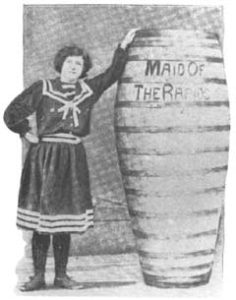 Martha WagenFuhrer successfully rode the Niagara rapids and whirlpool sealed in a barrel.
Martha WagenFuhrer successfully rode the Niagara rapids and whirlpool sealed in a barrel.
The barrel pitched and spun and was swept into the Whirlpool. And there it stayed, going round and round in a sickening circuit, for over an hour.
As the light faded, watchers had a hard time keeping track of Martha, her dark barrel lost against the dark water. Along the Canadian side of the river, rescuers lit fires near the places where the Whirlpool usually disgorged objects, and they waited. Finally the barrel sprung free, and, with a great shout of triumph, rescuers seized it and wrapped it with a towline. Ashore, they broke into the cover and pulled the woman out. Martha Wagenfuhrer was unconscious, but she was breathing. After ten minutes on shore, she came to.
Her celebrity was overshadowed by the actions of Leon Czolgosz a.k.a. Fred Neiman.
Outside, in the sweltering air, some people had been waiting in lines for more than an hour. Nieman had been waiting. Despite the temperature, he looked pulled together. He wore a laundered shirt, a vest, and jacket, and he had combed, parted and oiled his hair. Â He kept one hand in his pocket and his fingers closed around his handkerchief. His handkerchief, in turn was wrapped around his gun.
…
As close as anybody could remember, it was 7 minutes past four.
It was Neiman’s turn to shake hands.
Instead of his palm, he brought forth his revolver.
And fired.
The subsequent depiction of McKinley’s drawn out death is eerily reminiscent of the suffering that James Garfield went through (see WWTFT review of Candace Millard’s excellent Destiny of the Republic). In Garfield’s case his doctors’ ineptitude and carelessness killed him. With McKinley, it was simply the fact that the medical science of his time was not advanced enough to save him.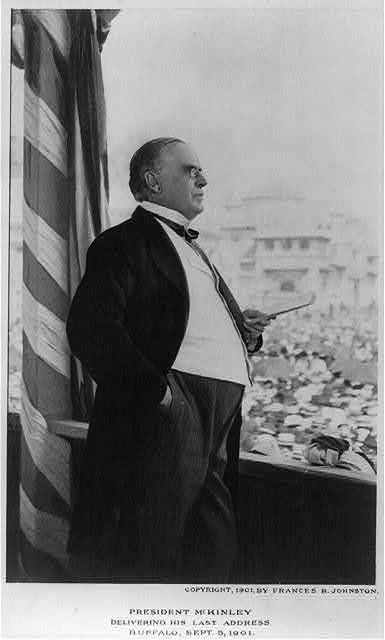
Creighton toggles smoothly between the assassination and other events and characters in Buffalo.  And so, here is yet another woman eager for fame and perhaps fortune who decided that the best way to attain them was to go over the falls in a barrel … with her dog.
Maud Willard’s barrel ride was supposed to be part of two stunts.  Professional stuntman Carlisle Graham had lent Maud his own barrel (he’d made several successful trips over the rapids.) The plan was for Graham to jump in the river opposite the Whirlpool swim across and latch onto the barrel after it successfully traversed the rapids and exited the Whirlpool.
Having been nearly killed by her own barrel run, Martha Wagenfuhrer had done her best to urge Maud to drop the idea. Others wondered about taking the dog. What was the point? There was only one small airhole [sic] in the barrel. She was told to leave her dog ashore.
Maud didn’t listen.
At ten minutes to four, in view of hundreds of spectators clustered along banks and jammed overhead on the steel-arch bridge, a small boat towed Maud’s barrel to the center of the river and cut it free. Within seconds the barrel was thrown about by the rapids, but it remained upright and moved fast. In less than eight minutes it had traveled into the Whirlpool.
Graham completed his long swim through the rapids successfully and rested, unaware of what Maud was enduring.
He had not seen what others had witnessed — that, at 5 p.m. after her barrel had made more than thirty revolutions around the Whirlpool, her barrel had been sucked down by an undercurrent and had disappeared for several minutes.
Nearly 5 hours after entering the river, the current finally changed.
Two local brothers swam to the cask and pulled it to the rocky bank.
… Maud hadn’t taken anybody’s advice. She had carried a dog with her, for God’s sake. And when the men broke open the top of the cask and looked in, there he was. He was sitting on Maud’s face, his nose to the airhole.
Maud wasn’t so lucky.
She hadn’t died easily … Her lips were blue, her body was bruised, and “the facial expression denoted much suffering.â€
Maud wasn’t the last of the crazy women barrel riders who appear in Creighton’s tale. Sixty-three-year-old Annie Taylor’s story is one of the most interesting in the book – but this review will leave it to the reader to discover it and decide for themselves whether to admire or pity her. She survived the trip, but it did not yield the results on which she had counted.
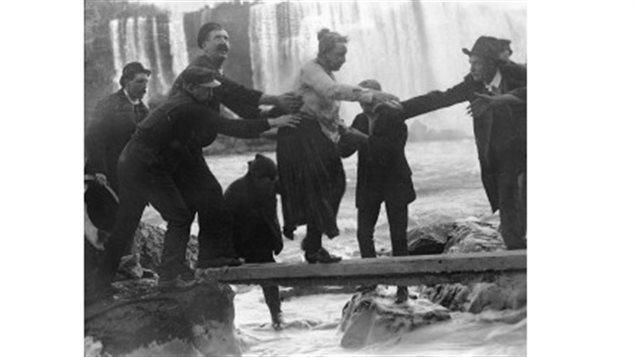
The Devil in the White City contains a lot of detail and history, but revolves around the devil (Dr. Henry Holmes) in the story. Creighton’s book has two major villains, and it’s time to introduce the second.
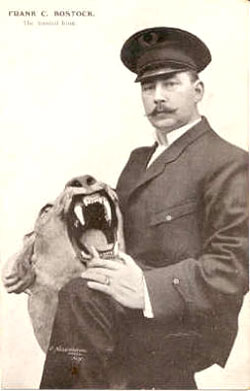
Frank Charles Bostock was a skilled promoter and famed for this exhibits of beasts and curiosities. He lobbied successfully to provide one of the main attractions in the Buffalo exhibition. He was quite famous in his day and by many accounts, charming and accommodating. However, the Bostock that Creighton unearths cared for nothing but himself and was willing to perpetrate tremendous cruelty (and likely enjoyed doing so.) He treated his most prized exhibit – Alice Cenda – no better than he did one of the animals in his menagerie. The reader gets a hint of his “showmanship” at the beginning of the book when he plans to electrocute Jumbo the elephant as a grand finale to the exhibition.Â
Alice Cenda, aka Chicquita fell into Bostock’s clutches in 1895 when he took her under contract for perhaps $80 month – but he held onto her money.  By some accounts he brought in $1000 per month to exhibit her. She was 26 inches tall – “A perfect living, breathing doll†managers like Bostock would claim.
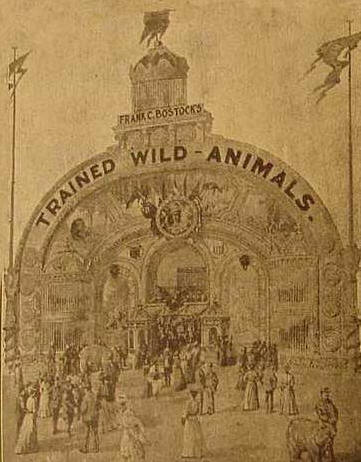 |
 |
Creighton recounts how Bostock took advantage of Cenda – he kept her locked up like an animal and even beat her. At one point Cenda escapes but is recaptured. Bostock eventually hired a husband and wife team of keepers to ensure that she did not escape. Alice Cenda does find happiness and finally manages to escape from Bostock.
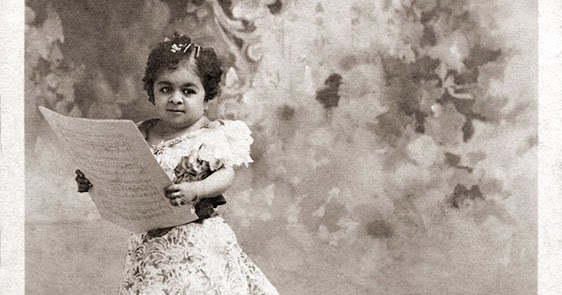
There are too many fascinating details to do them justice in the space of this review. Unfortunately, much is consequently missing here – not least of which is the reason for the title.
Like The Devil in the White City, a good portion of the book is devoted to the work involved in putting on the fair. The city of Buffalo hoped to exceed the success of the Chicago World’s fair a decade earlier.  A changing society and assassination of a president ensured that this would not happen. In fact, its stockholders and the city of Buffalo lost money in the endeavor. Ultimately, the federal government had to ameliorate some of the losses. The Electrifying Fall of the Rainbow City is a tale mixed with tragedy and disappointment but one filled with interesting events and historical significance.
Creighton chooses to focus on societal and cultural significance of the Buffalo fair and stops just short of drawing unsupported conclusions. This reviewer had some concerns that the book might be ruined at the end by injecting too much of the modern social mores into a time when such things couldn’t have been contemplated. Fortunately, Creighton says what she has to say in a plausible and thoughtful manner. This is a really interesting book.
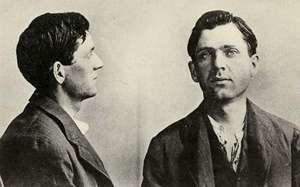
 The posts are coming!
The posts are coming!


0 comments
Kick things off by filling out the form below.
Leave a Comment